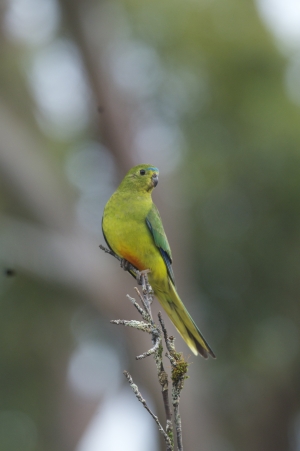New hope for Australian parrots
Research news
With only around 30 to 40 left in the wild, the Geelong-based orange-bellied parrot has been ranked one of the world’s rarest and most endangered species. However, a new Australia Research Council grant is offering new hope for these parrots, which spend a good deal of their life in the Geelong region.
Announced in late June, the funding, worth over $470,000, has been awarded to researchers in Deakin’s Centre for Integrative Ecology, in partnership with Zoos Victoria, the Victorian Department of Environment and Primary Industries, and Charles Sturt University.
Researchers at the new Geelong Centre for Emerging Infectious Diseases will also be involved in the project. This centre is a collaboration between Deakin, Barwon Health and the CSIRO Australian Animal Health Laboratory (AAHL).
The new four-year research project will focus on two globally significant avian pathogens, Psittacosis, and Beak and Feather Disease Virus. The researchers will develop critical knowledge and tools to help manage the pathogens, which – apart from threatening the orange-bellied and other Australian parrots - are causing significant conservation, agricultural and public health concerns around the world.
Led by researchers from Deakin, the project will explore disease transmission dynamics, and the role of genetic diversity, habitat and bird stress in infection and disease emergence across southern Australia.
They will also examine how poultry and human infection is related to infection in wild birds.
Deakin’s Professor Andy Bennett explained that Beak and Feather Disease virus is listed by the Federal Government as a “Key Threatening” process to biodiversity, and psittacosis can be lethal to humans.
“About 70 per cent of emerging infectious diseases in humans come from animals, so we need to be on top of these processes. Besides, disease can have a major impact on wildlife populations,” Professor Bennett said.
“Geelong is the Silicon Valley of animal disease research in Australia. These additional funds will allow us to both reduce the risk of extinction of the orange-bellied and other parrots, and improve our understanding of the risks of infectious diseases being transmitted to humans.”
He added that orange-bellied parrots are particularly vulnerable to beak and feather disease virus in their captive breeding program at Healesville Sanctuary. This program began in 1994 and now cares for around 300 orange-bellied parrots, who comprise the fragile “insurance population” against extinction.
Deakin researcher, Dr Mathew Berg, explained that the remaining wild orange-bellied parrots divide their time between Geelong and South West Tasmania, where their nesting area is protected within a World Heritage Zone.
“The orange-bellied parrot is one of only three parrot species that migrate and it spends its winters near us in Geelong,” he said.
“This little parrot has been of great concern to scientists and conservationists over the past 30 years or so. Unfortunately, it’s not alone though, with around a third of parrot species in Australia and around the world considered at risk of extinction.”
Only a little bigger than a budgerigar - with a small bright orange patch on its belly - the parrot was once abundant, but has lost much of its wintering grounds to development and competition for nesting sites from introduced species such as starlings.
The present population is now so depleted that it is highly susceptible to catastrophic natural events and disease epidemics.
Share this story
 Survival in the balance - the orange-bellied parrot. (Photo: Barry Baker)
Survival in the balance - the orange-bellied parrot. (Photo: Barry Baker)
